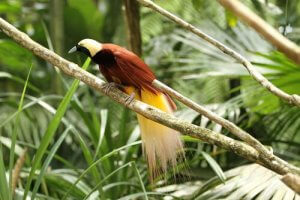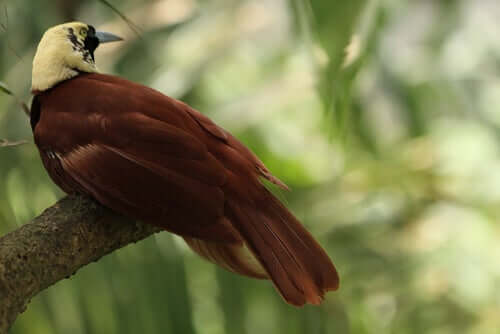Birds of Paradise: Species and Characteristics


Written and verified by the lawyer Francisco María García
Birds of paradise are a type of tropical, exotic bird with 41 different species. Most of them live in New Guinea, although you’ll also see some in Australia. They belong to the Paradisaeidae family within the Passeriformes order.
They have feathers that really stand out for their amazing blends of color and pattern. They’ve always been a source of inspiration, whether for the native communities around them, or for artists all over the world.
The general characteristics of birds of paradise
Besides their colorful looks, these birds have some other interesting characteristics:
- There are lots of differences between the 41 subspecies, but they obviously have some aspects in common too. One of those is their non-webbed fingers: one towards the back and three towards the front.
- They live in the crowns of trees, and only interact with each other during mating season. That’s when you’ll see the amazing interplay of color and rhythm, because birds of paradise have some truly breathtaking mating rituals. They do balancing acts, walk backward, and will even hang upside-down in order to attract a mate.
- Birds of paradise have different diets depending on where they live and what the circumstances are. Some eat only berries and fruits. Others eat small insects like spiders and worms.
- Birds of paradise are also sexually dimorphic. The males are colorful and big, whereas females often have more neutral colors like brown.
- During mating season, females choose the males that create the best effect with their movements and feathers. After mating, they leave the males to devote themselves to building a nest and raising their chicks.

Bird of paradise subspecies
- The greater lophorina: this is one of the most-well known subspecies because of the show males put on during mating seasons. Females have brown feathers with light and dark spots. Males are generally a bluish black with a metallic blue head and tail. Males of this subspecies dance by lifting their wings and moving ostentatiously around the female. They’re about 10 inches long.
- The raggiana bird of paradise: this is one of the biggest subspecies, at nearly 30 inches and weighing over one pound. You can tell them by their black chests, yellow and green heads and tails, and brownish-red backs. Besides looking gorgeous, this subspecies is also an important part of New Guinea’s ecosystem. Their eating habits make them accidental seed spreaders. It’s thanks to them that nutmeg and chestnut are so plentiful in the area.
Different shades and shapes of their feathers
- The Paradise-whydah: these have a sandy-white chest that fades into orange tones towards the neck. The rest of their body is black. Their long tails are one of their most striking features. They’re native to Eastern Africa.
- The Greater bird of paradise: this is one of the most beautiful of all the subspecies. There’s a perfect separation of the colors between their feathers. Their white head looks like a helmet covering their wings, and their neck is usually a reddish-brown color. The greater bird of paradise draws attention by lifting the yellow feathers on its tail into a kind of fan. This subspecies can reach a height of nearly 5 inches
- Wilson’s bird of paradise: the tail and back of this subspecies are almost surreal-looking. Their tails are made up of two thin, blue, spiraling feathers. Their chests have a bright red and blue pattern, set against a black background. It’s not always easy to find Wilson’s birds of paradise to observe. One of the main reasons for that is that they live about 4,000 feet up in the thick forests of Indonesia.
- The king bird-of-paradise: the back of this subspecies of the bird of paradise are bright red, softening into white on their chests. Their heads look like crimson helmets. There’s a touch of green behind their necks that makes their plumage like a work of art. Their feet are a purplish-blue.
The dangers facing birds of paradise
The belief that their feathers bestow magical powers has been fatal for these birds for centuries upon centuries. People also hunt them for their meat, which is seen as a delicacy in many native communities in New Guinea.

Land developers are also starting to encroach on their habitat. This is one of the biggest extinction risks for birds of paradise right now.
Birds of paradise are a type of tropical, exotic bird with 41 different species. Most of them live in New Guinea, although you’ll also see some in Australia. They belong to the Paradisaeidae family within the Passeriformes order.
They have feathers that really stand out for their amazing blends of color and pattern. They’ve always been a source of inspiration, whether for the native communities around them, or for artists all over the world.
The general characteristics of birds of paradise
Besides their colorful looks, these birds have some other interesting characteristics:
- There are lots of differences between the 41 subspecies, but they obviously have some aspects in common too. One of those is their non-webbed fingers: one towards the back and three towards the front.
- They live in the crowns of trees, and only interact with each other during mating season. That’s when you’ll see the amazing interplay of color and rhythm, because birds of paradise have some truly breathtaking mating rituals. They do balancing acts, walk backward, and will even hang upside-down in order to attract a mate.
- Birds of paradise have different diets depending on where they live and what the circumstances are. Some eat only berries and fruits. Others eat small insects like spiders and worms.
- Birds of paradise are also sexually dimorphic. The males are colorful and big, whereas females often have more neutral colors like brown.
- During mating season, females choose the males that create the best effect with their movements and feathers. After mating, they leave the males to devote themselves to building a nest and raising their chicks.

Bird of paradise subspecies
- The greater lophorina: this is one of the most-well known subspecies because of the show males put on during mating seasons. Females have brown feathers with light and dark spots. Males are generally a bluish black with a metallic blue head and tail. Males of this subspecies dance by lifting their wings and moving ostentatiously around the female. They’re about 10 inches long.
- The raggiana bird of paradise: this is one of the biggest subspecies, at nearly 30 inches and weighing over one pound. You can tell them by their black chests, yellow and green heads and tails, and brownish-red backs. Besides looking gorgeous, this subspecies is also an important part of New Guinea’s ecosystem. Their eating habits make them accidental seed spreaders. It’s thanks to them that nutmeg and chestnut are so plentiful in the area.
Different shades and shapes of their feathers
- The Paradise-whydah: these have a sandy-white chest that fades into orange tones towards the neck. The rest of their body is black. Their long tails are one of their most striking features. They’re native to Eastern Africa.
- The Greater bird of paradise: this is one of the most beautiful of all the subspecies. There’s a perfect separation of the colors between their feathers. Their white head looks like a helmet covering their wings, and their neck is usually a reddish-brown color. The greater bird of paradise draws attention by lifting the yellow feathers on its tail into a kind of fan. This subspecies can reach a height of nearly 5 inches
- Wilson’s bird of paradise: the tail and back of this subspecies are almost surreal-looking. Their tails are made up of two thin, blue, spiraling feathers. Their chests have a bright red and blue pattern, set against a black background. It’s not always easy to find Wilson’s birds of paradise to observe. One of the main reasons for that is that they live about 4,000 feet up in the thick forests of Indonesia.
- The king bird-of-paradise: the back of this subspecies of the bird of paradise are bright red, softening into white on their chests. Their heads look like crimson helmets. There’s a touch of green behind their necks that makes their plumage like a work of art. Their feet are a purplish-blue.
The dangers facing birds of paradise
The belief that their feathers bestow magical powers has been fatal for these birds for centuries upon centuries. People also hunt them for their meat, which is seen as a delicacy in many native communities in New Guinea.

Land developers are also starting to encroach on their habitat. This is one of the biggest extinction risks for birds of paradise right now.
This text is provided for informational purposes only and does not replace consultation with a professional. If in doubt, consult your specialist.








